Outline Boat on Water Easy Outline Drawings
- Home
- Landscape drawing
- Drawing a boat
Drawing a boat as a focal point in your landscape
Boats have featured heavily in art, and there are many artists out there who produce wonderful images with them as the main subject. However, we are going to look at drawing a boat as an additional element within a coloured pencil landscape. Let's look at a few ways we can do this.
Getting the shape right when drawing a boat
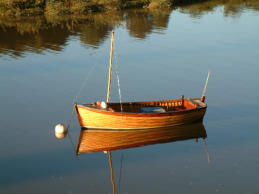 Boat on the River Tamar
Boat on the River Tamar
Different types of boat
On flat water, like rivers and lakes, many of the boats you will see have fairly regular shapes and simple construction. This allows you to draw them from the side view with straight lines along most of the drawn edges. See the example of a boat on the River Tamar at Calstock.
Small seagoing boats will probably have a more complex shape as they will be designed to cope with heavy waves and are more solidly built. They often have more pronounced curves - so your drawn lines will also be curved.
See the examples below of a white boat on the North Somerset coast and the blue ones at Whitby in North Yorkshire. We will look at drawing boats of both types, in perspective, and at easy ways to get the shapes right.
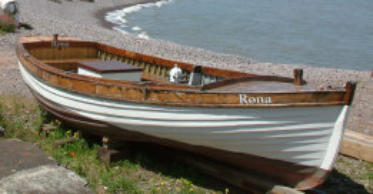
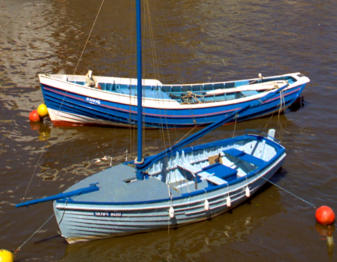
Drawing a river boat on land
First we will have a quick look at a pencil sketched outline of a river boat - one that is not severely curved.
The recommendation here is to draw out a rectangular box in perspective, mark the centre line front and back, then draw the boat within the box. This way you will get the sides and curves in correct perspective and the bow in the middle.
The two examples of boat drawings below should give you the idea if you want to learn how to draw a boat of this type...
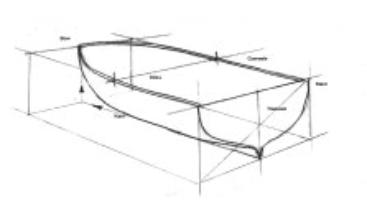
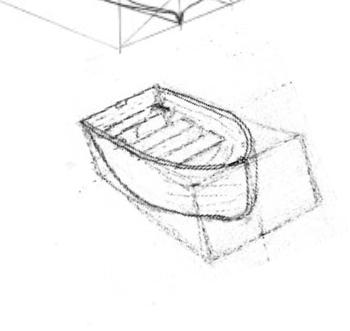
The graphite sketches above show boats hauled up on beach. When drawing a boat in the water the view will differ, of course.
Drawing a sea going boat in simple steps
It all becomes more complicated with the greater curves of the coastal boat, where there can be a very pronounced rise to the bows. Drawing the curves is complicated by the fact that you are usually looking at the boat from a side angle as the two curves in the hull (upwards and inwards) create complex problems for accurate drawing.
There is a way of determining the correct way the curves run when you look at the boat from the side, front and back.

Look at the way the gunwale flows and how the curves appear to go in opposite directions on either side of the top of the boat. We can describe the shape as a figure eight which has been flattened out.
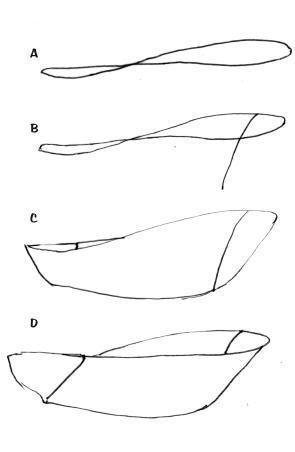
Let me draw out a figure eight shape - on its side - and develop that into a boat. You will see that by changing the shape of the 'eight' and changing the position of the bows and the stern, we can cover almost any view.
In Figure A the basic outline of the flat figure eight has been drawn. You will find that most shapes of 'eight' will produce the top outline of the boat hull, but some will be more suitable than others. Practice tells you the best shape.
In Figure B I have decided to have the bows to the right and I now need to decide whether the boat is facing towards me (Figure C) or away from me (Figure D).
In Figure C I have erased the lower right hand line and drawn in the stern (or Transom).
In Figure D I have erased part of the bow line and erased part of the lower hull line to the left. In both cases I have then completed the line of the keel.
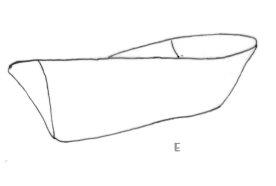
Just to show how the same 'figure eight' can produce a good outline for a boat facing the other way, I have used the identical outline for the boat top and drawn an alternative hull shape in Figure E.
The drawn shape of the figure eight is a good guide when drawing a boat of this type, but don't stick to it like glue! The aim is to provide a master for those difficult opposing curves along the top edges. Once you have drawn in your finishing lines, any surplus drawn lines can be erased.
Clinker built vessels
Remember that if the boat has been clinker built from overlapping planks of wood, the lines of the planks will follow the shape of the curves. Look again at the photos near the top of the page. "Rona" is clinker built, as are the two boats at Whitby.
In modern boat building, you can get glass reinforced plastic boats (GRP) that look like clinker built boats - they are simply taken from a full sized mould of a traditional boat.
Many river and shallow water boats will have smooth surfaced outside surfaces and will be built from sheet ply or GRP. These have much less artistic interest.
Drawing a boat in water
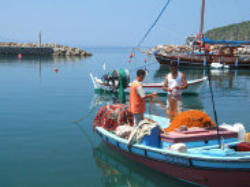
The critical word is IN. Boats move through water and sit in the water. They don't move and sit ON it.
Look at the way this foreground boat is low in the water with the weight of the two fishermen and their nets and tackle.
You need to allow for a curve at the waterline as well as along the gunwale if the boat is in the water - and your eye is not much above the actual water surface.
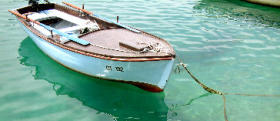
The higher your position, the more pronounced the curve. In the lower image, the water is so clear that it is difficult to see the actual point where water meets air. Boats are actually wider than you imagine them. They are not all as slim built as kayaks.
A guide to ripples and reflections in water
Ripples
Let's now have a think about water and the appearance of ripples on the surface, and how those ripples affect reflections and the lightness of the water surface.
The first thing to consider is the way the angle of view of the water surface affects the amount of reflection of light. If you look at a still clear water surface from a position slightly above the water, there is a point where you no longer look down through the water to the bed of the pool, but see only a reflection of the sky or view above and ahead.
The first image below shows that at an angle of around 45 degrees (not exact - I haven't measured it) is the margin where the view changes. At around 45 degrees there is a merging of views - not a clear cut off.
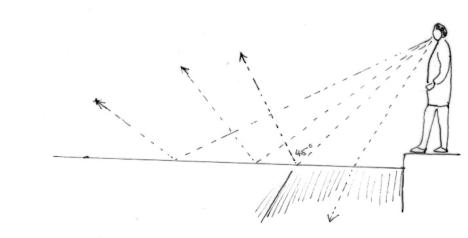
If you get slight waves on the water as is shown below, the angles of 45 degrees occur it various points and where the angle is sharper than 45 degrees the water will appear darker. Where the angle is more than 45 degrees the water will appear lighter, as more light will be reflected towards the eye. This is the reason for those light and dark ripples you see on the water surface.
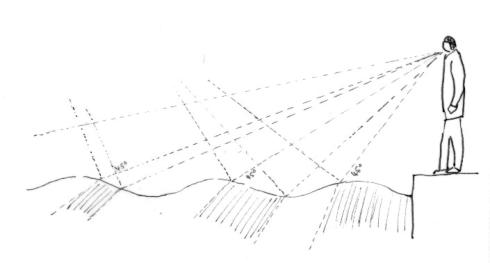
If you have something like a boat reflected in the water, the calculations become more complicated as there are two elements conflicting.
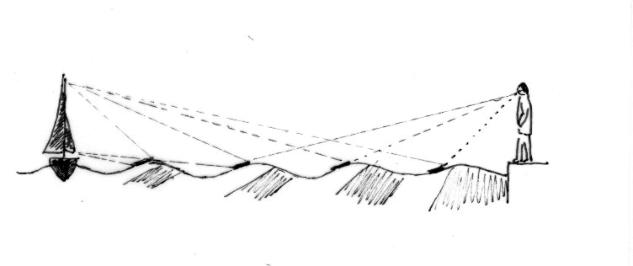
Usually, we see the image on the left below, but the image is often broken up by the varied surface angles. Sometimes we see the picture on the right, where the reflected image in the water is also broken up. The theory predicts the picture on the right, but in practice the picture on the right is more often seen.
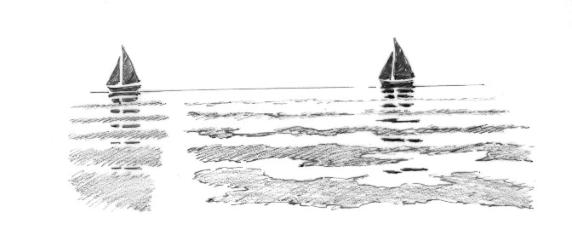

To conclude this brief tutorial we also need to think about how surface disturbance can throw out our calculations on the position of reflections.
If the boat itself is moving through the water the speed and the weight of the vessel will affect the ripples in its wake. You will also need to add the width of the waterway and the weatherto this equation. Each of these factors will have an effect on the distribution of movement over the surface of the water.
Things to keep in mind when drawing reflections
Remember how we said that the reflection of something in the water is the same height as the actual image itself, (as we see it above the water) but that the reflection is the view as we would see it from a position under the water? Therefore if we look at a reflection of a boat, we see the view of the hull from underneath. Check this with another look at the small boat on the River Tamar at the top of this page. From the bank we can see inside the boat. The reflection sees no inside.
It is a common error to be thrown out by a non-reflective surface between us and the image. See the drawing of the two rocks below.
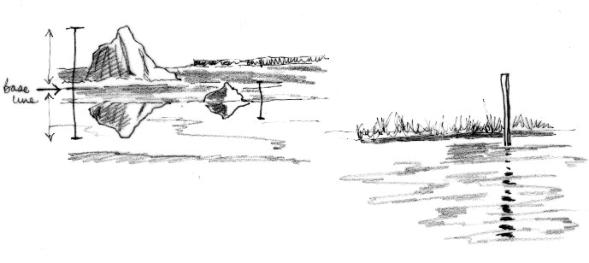
There is a section of broken water near to the large rock and that breaks the surface image up. The temptation might be to measure our reflection from the edge of the broken water. This would be wrong. We need to measure the equal distance from the base of the rock so our reflection in the calm water only shows the top of the large rock. The small rock is on the edge of the calm water so all the reflected image is shown.
If we get ripples, this will throw out our calculations and the reflected image could well appear much longer than the original as the wave structure is picking up the reflection over a greater distance - as in the drawing of the post to the right. The width of the reflected post may also be thrown out as well by the water angles.
This is a complex area for examination and I may well return to it at a future date, but hopefully you will have a clearer understanding of why we see what we see in waves and ripples and reflections of things on the water.
I hope this page has given you some pointers for the next time you are drawing boats in or off water, along with their reflections.
- Home
- Landscape drawing
- Drawing a boat
Would you like our occasional newsletter?
Source: https://www.pencil-topics.co.uk/drawing-a-boat.html
0 Response to "Outline Boat on Water Easy Outline Drawings"
Post a Comment